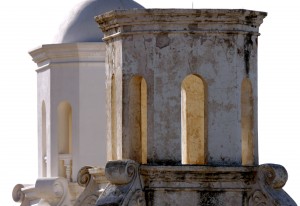
[Source: Doug Kreutz, Arizona Daily Star 3-28-2010] — A prominent feature of Mission San Xavier del Bac, which has graced the desert southwest of Tucson for two centuries, faces unchecked decay now that critical funding has been cut. Work to repair and restore the mission’s deteriorated east bell tower was supposed to be under way this spring, but not a dab of new mortar has been applied.
A previously approved $150,000 grant from the Arizona Heritage Fund to kick-start the project was abruptly canceled last year. Persistent efforts to get the funding restored have failed, so the bell tower will languish for the foreseeable future — making eventual restoration ever more costly, said Vern Lamplot, executive director of the Patronato San Xavier. The group oversees fundraising and restoration for the mission, which attracts 200,000 visitors annually.
Restoration of the tower was to be the last major step in more than two decades of work that has included repair of walls, renovation of the west tower and meticulous cleaning of religious art inside the mission. [Note: To read the full story, click here.]



You must be logged in to post a comment.